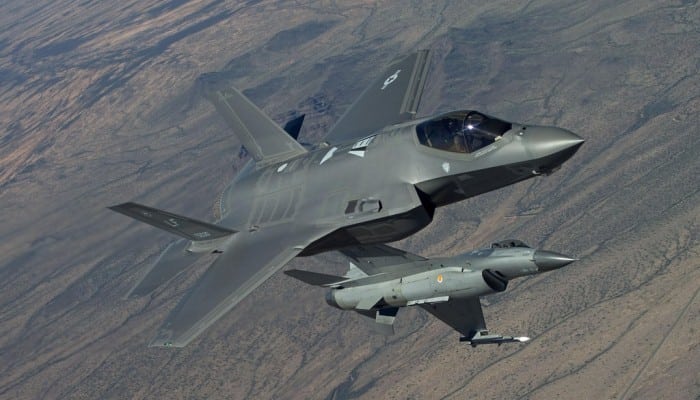[Avionics Today 10-07-2014] It’s no secret that with the introduction of the F-35 Joint Strike Fighter many challenges have emerged. For both the avionics market and for the militaries that rely on the aircraft and its secure mission capabilities in combat, the new F-35 brings a good deal of advantages but also important obstacles.
 |
F-35, F-16 fly together at Luke AFB. Photo: Lockheed Martin |
Guaranteeing secure, safe and efficient communications between the fifth generation F-35s and F-22s and the fourth generation F-18, F-16 and F-15 aircraft, has been a main challenge. And with the F-22 recently participating in many of the airstrikes over Syria, fifth-to-fourth generation communications are becoming ever more important — and ever more scrutinized.
“The acquisition of the Joint Strike Fighter has drawn a lot of criticism,” said General Michael Hostage, commander of air combat command for the U.S. Air Force, speaking at the Annual Air and Space Conference and Technology Exposition last month. “It is my professional judgment that recapitalizing our aging legacy fleet with fifth generation capability is a national imperative. Recapitalization of fifth gen ensures lethality and survivability against emerging high-end threats, delivering the best answer to the challenges posed today and in the future.”
During a portion of the Maryland conference entitled “Future of the Combat Air Force,” Hostage expressed discontent that the data link between fourth and fifth generation fighters isn’t up to par, amongst other complaints.
“Any airplane that has a pod is a potential non-traditional [Intelligence, Surveillance and Reconnaissance] ISR platform. Our challenge right now is how do I link that capacity with a tasking mechanism that gives them a useful task and then funnels the information back into the system in a timely fashion to the right customer,” Hostage said at the conference, noting that these fighters are compromising a secure Anti-Access Area Denial (A2/AD) environment for the military.
But creating these capabilities is proving difficult and with sequestration the U.S. Air Force is bumping up against the budget. “We must look to industry to supply better, faster and cheaper solutions to our existing capability gaps,” Hostage said.
And the industry is working to meet these needs. Northrop Grumman is among the aerospace companies that have been working to create systems that allow the F-22 Raptor and the F-35 Lightning II stealth aircraft to share information through existing data links with their fourth generation counterparts. The company demonstrated this fifth-to-fourth generation capability in May through a series of flight tests under the Joint Capability Technology Demonstration (JCTD) program known as Jetpack. The program is based on Northrop Grumman’s F-35 communications navigation suite but as of yet, the company hasn’t released further gains on the system.
Since Northrop Grumman designed and manufactured the avionics for the F-22 and F-35 fighters, the company now plans to construct the communication solutions desperately needed by militaries around the world.
“[The F-35s and F-22s] are modular integrated avionics systems that allow us to take the components of those systems and put them together in other ways to do similar functions or smaller subsets of functions,” said Jay Grove, vice president of business development at Northrop Grumman in an interview with Avionics Magazine. “An F-35 would have 30-plus [Communication, Navigation and Identification] CNI functions. An F-22 would have similar CNI functions. So taking a subset of that capability and creating Jetpack and then putting both the F-22 and F-35 wave form into the box is the unique solution that we brought to the JCTD program.”
Both industry and military see the need for these capabilities as high priority. The hope is that the two can come together quickly enough to stay one step ahead.
“The heart of fifth generation communications is integrated avionics,” Grove said. “Hosting software-reconfigurable avionics systems as well as the common modules and common software used in those systems makes for highly reliable functions and a small size, weight and power configuration.”
Smaller, more efficient software and hardware make a more reliable fighter, according to Grove, but fighter pilots need to be sure they can trust the communication systems if they are to coordinate effectively and securely. According to Grove, Northrop Grumman is planning to bring some of these new, secure communication system programs to the competitive space in the next 12 to 18 months. Hostage has made it clear the Air Force will welcome these new programs, as long as the industry can deliver on budget.
“The F-35 is the cornerstone to our continued success,” said Hostage. “And every possible action should be taken to ensure the Air Force acquires the full planned fleet while getting the greatest value for the dollar.”